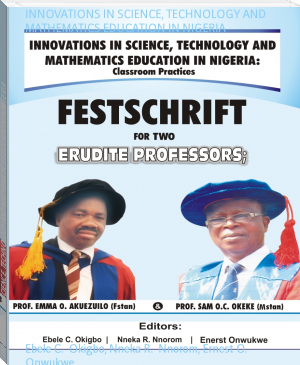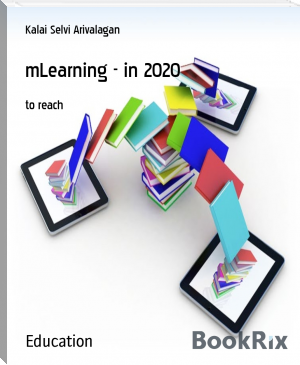INNOVATIONS IN SCIENCE, TECHNOLOGY AND MATHEMATICS EDUCATION IN NIGERIA, Ebele C. Okigbo, Nneka R. Nnorom, Ernest O. Onwukwe [best reads .TXT] 📗

- Author: Ebele C. Okigbo, Nneka R. Nnorom, Ernest O. Onwukwe
Book online «INNOVATIONS IN SCIENCE, TECHNOLOGY AND MATHEMATICS EDUCATION IN NIGERIA, Ebele C. Okigbo, Nneka R. Nnorom, Ernest O. Onwukwe [best reads .TXT] 📗». Author Ebele C. Okigbo, Nneka R. Nnorom, Ernest O. Onwukwe
The control group was taught geometry with CTM. The subject matter was presented to the students using charts as instructional materials to explain the concept of three dimensional shapes. The students listened and copied note on the board. At the end of the treatment which lasted for four weeks, post test was administered to both groups. Mean and standard deviation were used to answer the research questions while two-way Analysis of Co-variance (ANCOVA) was used to test the hypotheses at 0.05 level of significance.
Results
Research Question 1: What are the mean achievement scores of students exposed to HKC of three-dimensional shapes and those exposed to CTM in geometry?
Table1: Mean and standard deviation of achievement scores of students exposed to HKC and CTM in geometry.
Pre-test Post-test Mean() SD SD
Source of N Gain Pretest Posttest
Variation
HKC 135 14.53 66.56 52.03 8.01 11.71
CTM 139 14.89 44.42 29.53 7.94 17.38
The result presented in Table 1 reveals that the students exposed to HKChad a pretest mean achievement score of 14.53 with a standard deviation of 8.01 and a post test mean achievement score of 66.56 with a standard deviation of 11.71. The mean gain achievement score of the students exposed to HKC was 52.03.The students exposed to CTM had a pretest mean achievement score of 14.89with a standard deviation of 7.94 and a post test mean achievement score of 44.42 with a standard deviation of 17.38.The mean gain achievement score of the students exposed to CTM was 29.53.
Research Question 2: What are the mean achievement scores of male and female students exposed to HKC of three - dimensional shapes in geometry and those exposed to CTM in geometry?
Table 2: Mean and standard deviation achievement scores of male and female students exposed to HKC and CTM in geometry.
Statistics
Source of Gender N Type of Test SD
variation
HKC Male 59 Post test 67.004.96
Pre test 15.013.00
Gain 51.99
CTM Male 64 Post test 44.96 8.10
Pre test 14.29 3.77
Gain 30.67
Total 123
HKC Female 76 Post test 66.126.75
Pre test 14.055.01
Gain 52.07
CTM Female 75 Post test 43.889.28
Pre test 14.604.17
Gain 29.28
Total 151
The result presented in Table 2 reveals that the male students exposed to HKC had a pretest mean score of 15.01 with a standard deviation of 3.00 and a posttest mean 67.00 with a standard deviation of 4.96. The mean gain achievement score of male students exposed to HKC was 51.99.The female students exposed to HKC had a pretest mean score of 14.05 with a standard deviation of 5.01 and a posttest mean 66.12 with a standard deviation of 6.75.The mean gain achievement score of female students exposed to HKC was 52.07.
Table 2 reveals also that male students exposed to CTM had a pretest mean score of 14.29 with a standard deviation of 3.77 and a posttest mean score of 44.96 with a standard deviation of 8.10. The mean gain achievement score of male students exposed to CTM was 30.67.The female students exposed to HKC had a pretest mean score of 14.60 with a standard deviation of 4.17 and a posttest mean score of 43.88 with a standard deviation of 9.28.The mean gain achievement score of female students exposed to HKC was 29.28.
Testing of the Hypotheses
Hypothesis 1: There is no significant difference between the mean achievement scores of students who were taught geometry using HKC of three-dimensional shapes and those taught using CTM.
Table 3: Summary of Analysis of Covariance (ANCOVA) of achievement scores of students exposed to HKC and CTM in geometry.
Source
Type III Sum of Squares
Df
Mean Square
F
Sig.
Partial Eta Squared
Corrected Model
28868.563a
4
1873.035
14.500
.000
.629
Intercept
51977.480
1
51977.480
402.379
.000
.746
Pretest
3.705
1
3.705
.029
.866
.000
Method
22247.695
1
22247.695
172.229
.000
.557
Gender
4.752
1
4.752
.037
.848
.000
Method * gender
7.334
1
7.334
.057
.812
.000
Error
17697.022
268
129.175
Total
476444.000
274
Corrected Total
47665.584
273
a. R Squared = .629 (Adjusted R Squared = .585)
The result in Table 3 shows that there is a significant effect of HKC on students’ achievement in geometry F(1, 273) =172.229, P = 0.0005, partial η2= .557.The null hypothesis was therefore rejected. Hence, there is a significant difference between the mean achievement scores of students who were taught geometry using HKC of three-dimensional shapes and those taught using CTM.
Hypothesis 2: There is no significant difference in the mean achievement scores of male and female students who were taught geometry.
The result for this hypothesis is presented in Table 3.The result reveals that there is no significant difference in the mean achievement scores of male and female students who were taught geometry f (1, 273) =0.037, p = 0.848, (partial eta = .0005).The null hypothesis was therefore not rejected. This indicates that gender does not influence the mean achievement scores of students in geometry.
Hypothesis 3: There is no significant interaction effect of teaching method and gender on mean achievement scores of students in geometry.
The result for this hypothesis is as well presented in Table 3.The result shows that there is no significant interaction effect of teaching strategy and gender on students’ mean achievement scores in geometry F (1, 273) = 0.057, P = 0.812, partial η2= .0005.The null hypothesis was therefore not rejected. This means that the interaction effect of method and gender on mean achievement scores of students in geometry is not significant.
Discussion
The result revealed that the mean gain achievement score of the students taught geometry using HKC was higher than those taught with CTM as shown in Table 1. This meant that from the pre-test to the post-test, students taught geometry using HKC improved more than the students taught with CTM. In the pre-test, the standard deviation score of both groups of students were almost the same. However, in the post-test, the standard deviation score of the students taught with CTM was bigger than that of the students taught geometry using HKC. This is an indication that the marks obtained by the students taught geometry using HKC were closer together than those of the students taught with CTM. In other words, the gap between high and average scorers who were taught geometry was bigger in the CTM group as compared to the HKC group. Results in Table 3 further confirms that there is significant difference between the mean achievement scores of students who were taught geometry using HKC and those taught using CTM. Therefore, the students’ achievement in geometry is improved when taught using HKC, than when taught using CTM. It shows that teaching method has positive effect on achievement in geometry. This finding suggests that the use of HKC is more efficacious than the CTM. The likely factors responsible for this finding are students’ ability to visualize and manipulate the objects, motivation and interest generated by the HKC method. This finding is in consonant with the finding of Akaazua, Bolaji, Kajuru, Ma, Musa and Bala, (2017) who reported thatConcrete Manipulative Approach (CMA) improved the performance of students taught geometry concepts in Mathematics.
The analysis of data specifically male and female achievement scores presented in Table 2 showed that the male students who were exposed to HKC had higher mean gain achievement score than female students who were exposed to HKC. Likewise, the male students who were exposed to CTM had higher mean gain achievement score than female students who were exposed to CTM. The observed differences in mean achievement scores of male and female students were furthermore subjected to two-way ANCOVA as presented in Table 3. The result showed that there was no main effect of gender on the mean achievement scores of students who were taught geometry. That is, gender had no significant influence on students’ achievement scores. What this means is that gender does not influence the mean achievement scores of students who were taught geometry. This finding suggests that both high and low achieving male and female students who were exposed to HKC improved in achievement. The possible reason is that in course of revision, the low achieving male and female students who were exposed to HKC may have used the HKC repeatedly which enhanced their achievement. This finding is in agreement with the finding of Osuafor and Njoku (2016) who reported that there was no significant influence of gender on the mean achievement scores of students.
The result of hypothesis three shows that there is no significant interaction effect of teaching strategy and gender on students’ mean achievement scores in geometry. This finding agrees with the finding of Osuafor and Njoku (2016) who reported that the interaction effect of teaching methods and gender on students’ achievement scores in Mathematics was not significant.
Conclusion
In this study, it was concluded that HKC was effective for teaching three dimensional shapes in geometry in mathematics for senior secondary school students. It enhanced students’ achievement than CTM. Gender did not influence achievement of students in geometry. The interaction effect of method and gender on students’ achievement scores in geometry was not significant and did not influence achievement of students in geometry.
Recommendations
From the findings of this study, the following recommendation is made: The use of HKC should be encouraged by mathematics teachers in teaching three dimensional shapes in geometry because it enhances the achievement of the students.
References
Abiodun, I.O. (2016). Effects of information communication technology on senior secondary school students’ geometry retention and performance in Bauchi State. Unpublished masters thesis, Ahmadu Bello University, Zaria.
Ajayi, K.O., Abiola, L.O.,& Adeyanju, H.I. (2011) Effects of students’ attitude and self - concept on the achievement in secondary school mathematics in Ogun State, Nigeria. Journal of Research in National Development (JORIND), 9(2), 202 - 211.
Akaazua, J.T; Bolaji, D. C; Kajuru, Y. K; Mu, M; Musa, M &Bala, K. (2017). Effect of concrete manipulative approach on attitude, retention and performance in geometry among junior secondary school students in Benue State. IOSR Journal of Research & Method in Education (IOSR-JRME), 7, (6) 80-175.
David-Osuagwu, M.N, Onyeozili, I & Anemelu, C.(2011). New school mathematics for senior secondary schools 3rd ed. Ontsha: Africana First Publishers Plc.
Joshua, M.T.(2016). Communication technologies and Science, Technology, Engineering and Mathematics (STEM) education. Keynote address presented at the 57th Annual National Conference of Science Teachers Association of Nigeria from 15th-20th August, 2016 at Government College, Ado Ekiti.
Matthew, A. (2016). Students’ attitude and self - concept as correlates of their achievement in senior secondary school mathematics in Ankpa Local Government Area. Unpublished masters thesis,University of Nigeria, Nsukka.
Nigerian Educational Research and Development Council, (NERDC)(2007). New senior secondary education structure at a glance. Lagos: NERDC Press.
Nworgu, B. G.(2017). Modern teaching approach. Paper presented at the one day stakeholders’ forum on e-curriculum. Nigerian Educational Research & Development Council(NERDC).Retrieved from http:www.facebook.com/NERDC/.
Okigbo, E.C., & Okeke, E.U. (2011).A comparison of the use of card games and expository method in teaching and learning algebraic expressions. UNIZIK Journal of STM Education, 1(1), 18 – 24.
Okoli, J.N.(2011). Gender mainstreaming: A strategy for promoting gender equality in science and technology education. Science Teacher’s Association of Nigeria (STAN), 46(2) 98-107.
Osuafor, A. M. & Njoku, C.(2016).Effect of prior knowledge of behavioural objectives on mathematics achievement of high and low mental ability secondary school students in Imo State, Nigeria. People: International Journal of Social Sciences,2 (1) 255-264.
Secondary Education Management Board (SEMB), (2017). School statistics. Umuahia: Ministry of Education.
Vanguard, Newspapers (March 28, 2018).Senate inaugurates committee to investigate recurring mass failure. Retrieve from https://www.vanguardngr.com.
West African Examination Council (2016).Chief examiners report. Lagos: WAEC.
West African Examination Council (WAEC) (2008 – 2017). Chief Examiners’





Comments (0)